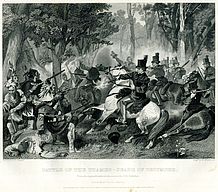Historian Spencer and Artist Chappel
 Enlarge
Enlarge
Francis Haskell has noted that there have been times “when seeing has appeared to provide a more useful way of understanding the past than reading,” and one such period may have been the 1850s in America. [63] This was certainly the belief of a writer for the Anglo-American who argued that when it came to knowing the “history of [our] own country,” citizens could “find more information . . . without trouble, at any time, and most agreeably, by a visit to the [rotunda paintings] in the Capitol” than they could get “from libraries of books.” [64]
This condition led to a friendly competition between historian and illustrator, one that increasingly favored the latter over the former even as it mutually benefited both. The desire on the part of readers in the mid-nineteenth century for highly sentimentalized historical portraits of their heroes may explain why Chappel’s illustrations had a potency that outpaced even Spencer’s dramatic prose. [Image 44] Chappel’s images, beautifully rendered and presented, certainly helped Spencer achieve a wider audience for the History of the United States than for anything else he had ever written. Spencer flattered himself that the “extensive circulation” of the pictorial history resulted from the fact that “[i]n spirit and tone” it was “considered to be fair and candid,” but he understood that it was Chappel’s illustrations that primarily sold the work. [65] A companion piece to the original volumes was issued in seventy-six parts in the 1860s, and the advertisements appearing on the back of the numbered pages suggest the degree to which images began to compete with words for preeminence in historical texts. There was little effort made to promote the reputation of Spencer in these commercials; he was acknowledged only in passing as the author of the series. But Chappel received a great deal of attention as the “well-known artist” and creator of the lavish “Pictorial Illustrations” for which “No pains or expence [sic]” had been spared, engraved as they were “in steel in the best style of the art.” [66] In this and other pictorial works, illustrators were listed on the bindings of books along with authors, sometimes achieving top billing.
These advertisements contributed to a mid-century trend in historical literature in which images became the clichéd representations of the historical events they depicted. Viewed by the public as nearly synonymous with the events themselves, pictorial images created by Chappel in works such as Spencer’s History of the United States were frequently over-reproduced in such numbers as to become symbolic as well as literal “stereotypes.” History paintings executed in the “grand manner” had always had a usurping effect on the historical imagination, but by the mid-nineteenth century the use of steel engraving and lithographic technologies of reproduction increased greatly the circulation and inviolability of canonical works by West, Trumbull, and Leutze.
Such duplicating technologies also encouraged multiple uses of an image and contributed to the quality and durability of these productions, ensuring their hold on the historical memory. By the 1870s illustrators had become so central to the manufacturing and marketing of such books that historians like Spencer began composing narratives in anticipation of the requirements of the artists like Chappel who pictorialized them. Indeed, some images became so dominant that they overshadowed all competing verbal or pictorial representations of the event, driving out all competitors and acquiring “the sort of authority that is derived from constant repetition.” [67] It became hard for historians to write in contradiction of these images as they became more standardized since audiences rejected all formulas that deviated in any way from the prior visual authority of the illustration. The authority of the visual had become irrefutable.

